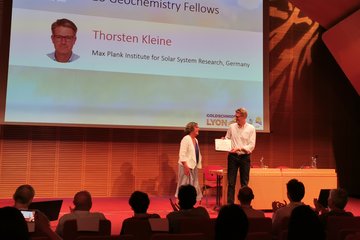Alle Typen
81.
Vortrag
Measuring active region inflows with local correlation tracking. Solar and Stellar Magnetic Fields - a conference in honor of Manfred Schuessler, Goslar, Germany (2016)
82.
Vortrag
Constraining the common properties of active region formation using the SDO/HEAR dataset. SDO 2016: Unraveling the Sun's Complexity, Burlington, Vermont, USA (2016)
83.
Vortrag
Solving the forward problem of helioseismology in the frequency domain. The 12th International Conference on Mathematical and Numerical Aspects of Wave Propagation, Karlsruhe, Germany (2015)
84.
Vortrag
Solar turbulent convection at supergranulation scale. Stellar and Planetary Dynamos, Göttingen, Germany (2015)
85.
Vortrag
Anisotropy of the solar network magnetic field around the average supergranule. Solarnet III / HELAS VII / SpaceInn Conference, Freiburg, Germany (2015)
86.
Vortrag
Dynamics of solar supergranulation. Advances in the seismology of the Sun and stars, Mumbai, India (2015)
87.
Vortrag
Data compression for helioseismology. SOLARNET III / HELAS VII / SpaceInn Conference "The Sun, the stars, and solar-stellar relations", Freiburg, Germany (2015)
88.
Vortrag
Measuring and interpreting the amplitude of the cross-covariance function of solar seismic waves. Astronomical Society of Japan spring meeting, Osaka, Japan (2015)
89.
Vortrag
Measurement of the amplitude of the solar cross-covariance function. Solarnet III / HELAS VII / SpaceInn Conference, Freiburg, Germany (2015)
90.
Vortrag
Simulating acoustic waves in spotted stars. Stellar and Planetary Dynamos, Göttingen, Germany (2015)
91.
Poster
Solar inertial modes: new observations and models. ESRP Meeting, Jena, Germany (2022)
92.
Poster
Monte-Carlo test of an improved multi-ridge fitting code for ring-diagram analysis. Dynamics of the Sun & Stars: Honoring the Life & Work of Michael Thompson , Boulder, CO, USA (2019)
93.
Poster
Towards improved multi-ridge fitting method for ring-diagram analysis. SDO 2018 Science Workshop: Catalyzing Solar Connections , Ghent, Belgium (2018)
94.
Poster
On the depth dependence of solar equatorial Rossby waves. Solar Dynamics Observatory Workshop Catalyzing Solar Connections, Ghent, Belgium (2018)
95.
Poster
On the depth dependence of solar equatorial Rossby waves. XXXth General Assembly of the International Astronomical Union, Vienna, Austria (2018)
96.
Poster
Comparison between time-distance and ring-diagram helioseismology measurements of subsurface convective flows. Annual Meeting of the Astronomische Gesellschaft 2017, Göttingen, Germany (2017)
97.
Poster
New insights on supergranular depth obtained through the resolution of the forward problem in local helioseismology. Astronomische Gesellschaft Meeting, Göttingen, Germany (2017)
98.
Poster
Measuring active region inflows with local correlation tracking. Seismology of the Sun and the Distant Stars 2016, Angra do Heroísmo, Portugal (2016)
99.
Poster
Multi-height Dopplergrams made from SDO/HMI filtergrams. Astronomical Society of Japan spring meeting, Osaka, Japan (2015)
100.
Poster
Simulating acoustic waves in spotted stars. HELAS VI/ SOHO-28/ SPACEINN Conference "Helioseismology and Applications", Göttingen, Germany (2014)











